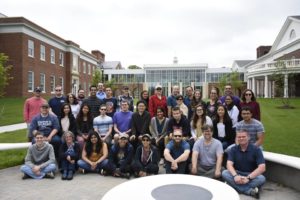
Each summer, TCNJ supports a robust, 8-week, residential research program named MUSE (Mentored Undergraduate Summer Experience), in which approximately 100 undergraduates engage in full-time, faculty-mentored research, scholarship, or creative activity. The summer MUSE program provides a cohesive set of coordinated activities and experiences designed to: (1) nurture student capacities to conduct original research in a collaborative and supportive environment, (2) advance research outcomes, and (3) strengthen TCNJ’s teacher-scholar/student-scholar community.
A sampling of some of the School of Science’s MUSE research teams for summer 2018 are highlighted below.
Read more about TCNJ’s Mentored Undergraduate Summer Experience program.
Dr. Joe Baker Research Group
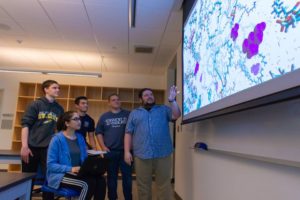
Chemistry professor Dr. Joe Baker and his students are working on molecular simulation projects, exploring the effects of particular solvents on the physical properties of cell membranes and on the structural stability of insulin. This research will deepen our understanding of the action of these solvents against bacterial biofilms and their impact on protein accumulation. The complex calculations for the simulations are being performed on the ELSA supercomputer at TCNJ.
Dr. Michael Bloodgood Research Group
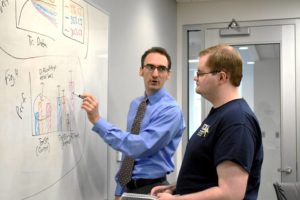
Computer Science professor Dr. Michael Bloodgood and his student Ethan Kochis ’20 are designing algorithmic solutions to problems in machine learning and natural language processing. Applications of their research include text classification, information extraction, and machine translation.
Dr. Angie Capece Research Group
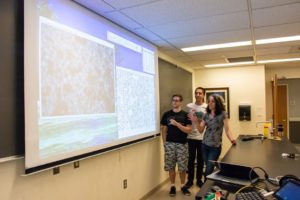
Physics professor Dr. Angie Capece and her students are studying plasma-synthesis of nanoparticles, which exhibit unique properties as a result of their shape and size, making them useful for a variety of applications from biosensors to catalysis.
Dr. Gary Dickinson Research Group
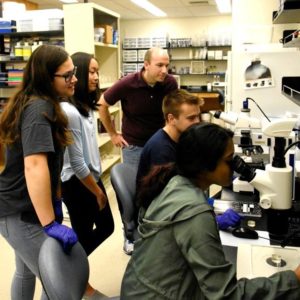
Biology professor Dr. Gary Dickinson and his students are studying the mechanics and structure of invertebrate shells, working with barnacles, Alaskan snow crabs, lobsters, and freshwater mussels to understand how the environment affects shell structure and mechanics.
Dr. Kathryn T. (KT) Elliott Research Group
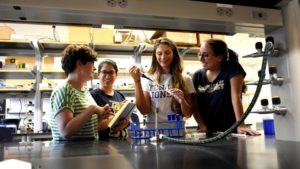
Biology professor Dr. KT Elliott and her students are using A. baylyi, a soil bacterium, to study genes implicated in the survival of DNA damage and in the ability of some pathogens to cause disease. Their research in bacterial genetics will provide insights into DNA repair in and diseases caused by other bacteria, but will also shed light on related genes that are found in everything from yeast to humans.
Dr. Nate Magee Research Group
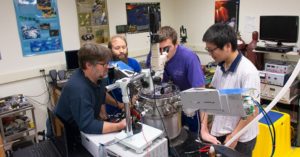
Physics professor Dr. Nate Magee and his students are working to recreate a –60º below-zero cirrus cloud in his physics laboratory. They are also capturing ice crystals from inside real cirrus clouds with a custom weather balloon instrument that they have built. These cirrus ice crystals are the first solid objects encountered by solar radiation as it enters Earth’s atmosphere – their detailed shapes and textures affect scattering of sunlight and impact climate-scale energy balances. Analyses in Dr. Magee’s lab and with #TCNJ’s unique cryo-scanning electron microscope are revealing the mysteries of these elusive crystals in unprecedented detail.
Dr. Janet Morrison Research Group

Biology professor Dr. Janet Morrison and her students are studying the effects that the overabundance of white tail deer and invasive plant species have on the plant communities in the fragmented forests of the suburban landscape.
Dr. Tuan Nguyen Research Group
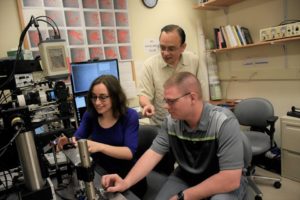
Physics professor Dr. Tuan Nguyen and his students are studying the physics of living neuronal networks, specifically how cultured nerve cells wire up to produce synchronized activity. Using an apparatus that combines laser scanning photostimulation and calcium imaging, they map the connections made within the network while recording the corresponding patterns of network activity. They seek to better understand how large populations of nerve cells fire together in rhythmic oscillations. In the brain, these oscillations are known as “brain waves” and important for understanding many neural phenomena such as cognition, sleep, and epilepsy.
Dr. Marcia O’Connell Research Group
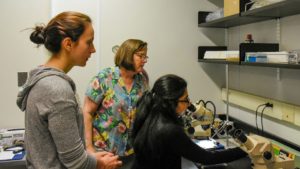
Biology professor Dr. Marcia O’Connell and her students are studying regulation of pattern formation during embryogenesis in zebrafish, and in particular what genes are required for proper patterning. These studies will help us understand how the embryos of vertebrates, including humans, acquire bilateral symmetry. Furthermore, an understanding of the molecular regulatory networks involved has applications in both evolutionary biology and medicine.
Dr. Dimitris Papamichail Research Group
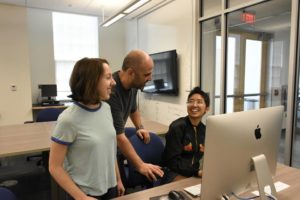
Computer Science professor Dr. Dimitris Papamichail and his students are designing algorithmic solutions to problems in computational biology, such as synthetic gene design and automated music transcription. Applications of their research include vaccine development and faithful automated transcriptions of music pieces for different instruments.
Dr. Nina Peel Research Group
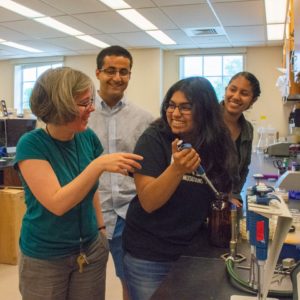
Biology professor Dr. Nina Peel and her students are using C. elegans, a small worm, to study microtubule function. Their research will give us a better understanding of human disease, as microtubules are important for cell division, neurons, and cilia function in both humans and worms.
Dr. Matt Wund Research Group
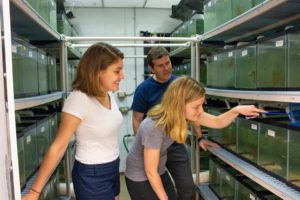
Biology professor Dr. Matt Wund and his students are investigating whether threespine stickleback fish use social cues from frightened neighbors to learn about potential predators. Exploring the role of learning from social information will inform their larger goal of understanding how widely distributed animals like stickleback identify and avoid the multitude of threats they encounter. They are particularly interested in how individual learning interacts with evolutionary adaptation.
